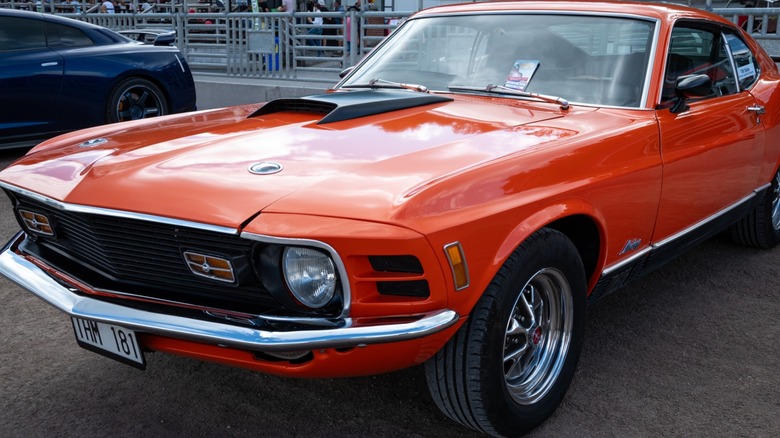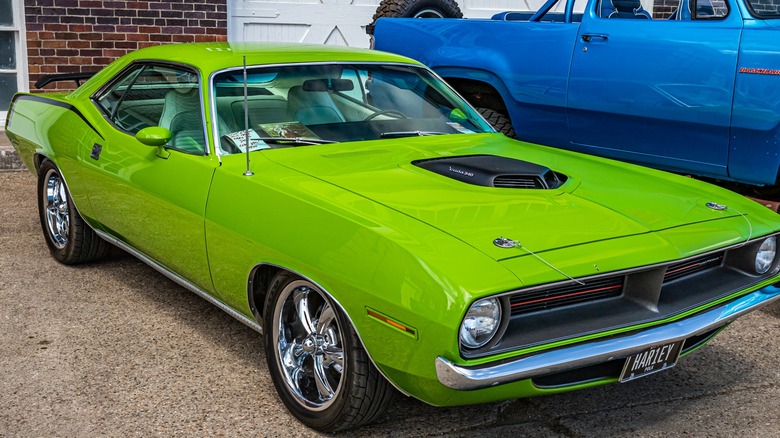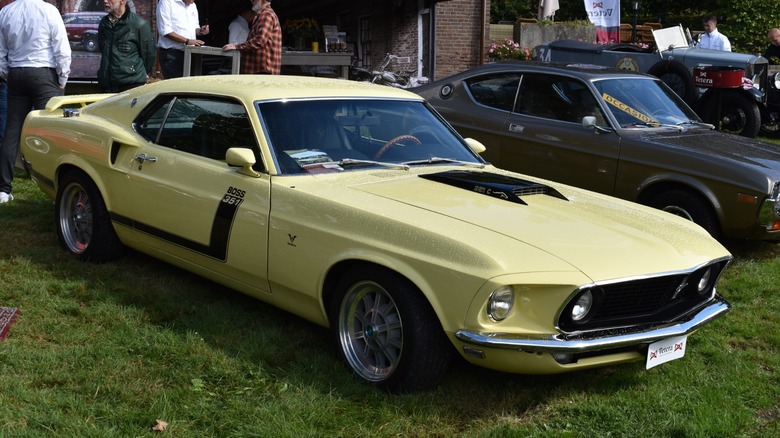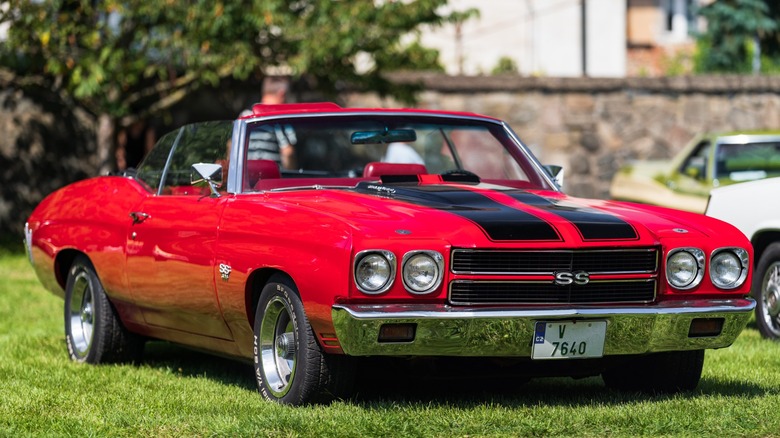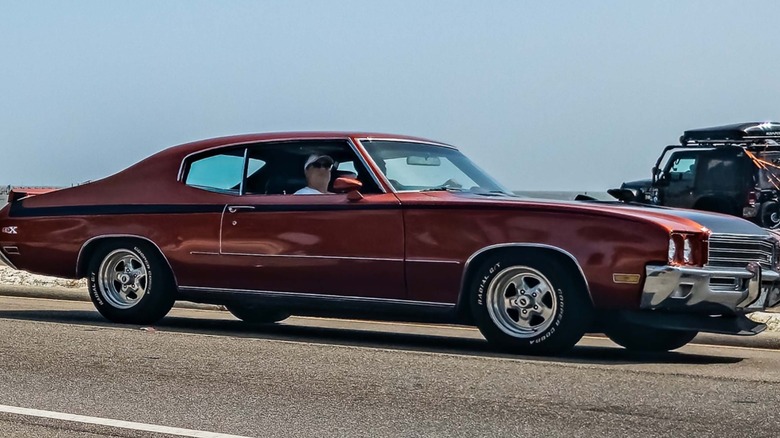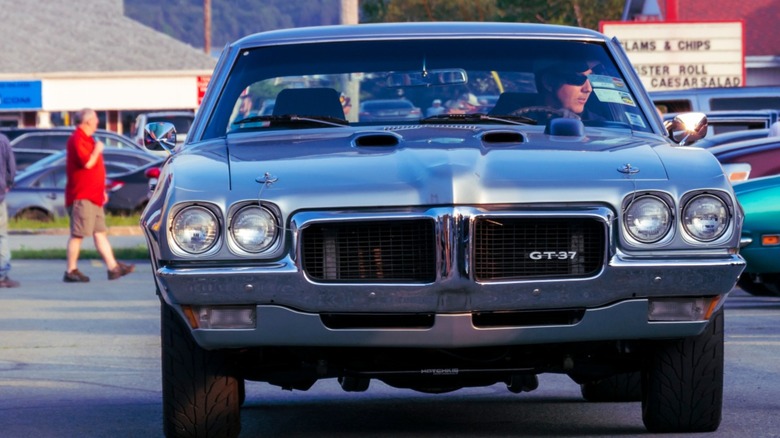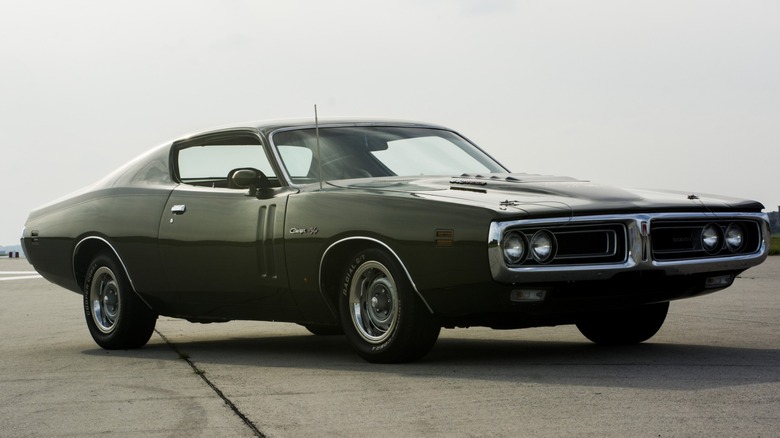6 Of The Highest Horsepower Muscle Cars Of The 1970s
Cars are like time capsules; they tell you so much about the era in which they were built. The 1970s was a pretty defining decade for automotive design. At the start of the decade, most major car manufacturers were locked in fierce competition, pushing the limits of horsepower and speed. This ultimately led to the creation of some of the most powerful and aggressive muscle cars the world had ever seen. But this golden age of muscle cars didn't last long.
Things were changing even in the early 1970s. Insurance companies began charging high rates for muscle cars, making them expensive to own. The government also introduced new rules to enforce stricter emissions standards, which inadvertently affected car performance. Then, in 1973, the oil crisis hit, causing gas prices to spike and forcing many buyers to prioritize fuel economy over speed.
As a result, the muscle cars of the 1970s represent in some way a final celebration of unrestrained performance before the industry shifted toward more practical cars. In this article, we'll look at six of the most impressive, high-horsepower muscle cars that defined this unforgettable decade.
Plymouth HEMI 'Cuda
What set the Plymouth 'Cuda apart from the Barracuda? Well, it was mostly sheer speed and power. At the 'Cuda's core was the legendary 426 HEMI V8 engine, officially rated at 425 horsepower and 490 lb-ft of torque. However, these numbers may have been downplayed, which was a common practice among manufacturers at the time to keep insurance costs lower. The engine's special hemispherical combustion chambers helped it take in more air, allowing it to make more power at higher speeds. The 'Cuda looked just as aggressive as it performed. It had a bold front grille, wide rear fenders and came in a range of eye-catching colors with fun names like "Black Velvet," "Sunfire Yellow," "Lime Green Metalic," and "Scorch Red."
But the upgrades were not limited to looks and engine power. The HEMI 'Cuda had a heavy-duty suspension, with stronger torsion bars in the front and reinforced leaf springs in the rear to handle the extra power. It also had brakes that featured, front discs and rear drums for better stopping power. Drivers could choose between a tough TorqueFlite automatic transmission or a four-speed manual with a Hurst pistol-grip shifter, giving them full control of all that muscle.
However, this power came at a significant cost. The HEMI engine option cost an extra $900, which was almost a third of the car's base price. On top of that, high insurance rates and poor fuel economy made it too expensive for most buyers. In 1971, only around 100 hardtops and 7 convertibles were built with the HEMI engine, making them some of the rarest muscle cars ever. Today, these cars are worth hundreds of thousands of dollars, and some have even sold for over a million.
Ford Mustang Boss 351
The 1971 Boss 351 was Ford's way of giving the legendary Boss Mustang lineup a proper send-off, and what a farewell it was. The model was powered by the 351 Cleveland V8 engine, which Ford specifically modified for high performance. We're talking about a solid-lifter camshaft, an aluminum intake manifold, a specially tuned four-barrel carburetor, and a unique dual-point distributor. All of this helped the Boss 351 produce 330 horsepower and 370 lb-ft of torque, making it one of the most powerful Mustangs of its time.
It could go from 0 to 60 mph in just 5.8 seconds and complete a quarter-mile run in 14.1 seconds. Ford paired the engine with a close-ratio four-speed manual transmission, allowing drivers to make the most of its high-revving powerband. To handle all that speed, Ford engineers gave the Boss 351 a competition suspension setup. It came with staggered rear shocks, where one shock faced forward and the other backward, to reduce wheel hop and improve traction under hard acceleration. The car also featured power front disc brakes and a quick-ratio steering system, which made it surprisingly agile for a muscle car of its size.
In terms of looks, the Boss 351 had a NACA hood scoop, bold black stripes on the hood, and subtle "Boss 351" to let people know this wasn't a regular Mustang. The chrome bumpers and trim added a touch of style. However, its wide roof pillars and seat positioning made it harder for drivers to get a clear view out the rear window.
Nonetheless, the Boss 351 remains a special part of Mustang's history. While future Mustangs would eventually surpass its performance, it really was just the most refined version of Ford's first-generation high-performance Mustangs until the Boss name was revived decades later.
Chevrolet Chevelle SS 454
The 1970 Chevrolet Chevelle SS 454 LS6, one of the most powerful production cars ever built in Detroit and arguably one of Chevy's most impressive muscle cars ever, featured the now-legendary LS6 454 cubic-inch V8 engine. This engine officially delivered about 450 horsepower and a massive 500 lb-ft of torque. What made this engine so special was its incredibly high compression ratio of 11.25:1, a solid lifter camshaft, large square-port heads, and an 800 CFM Holley four-barrel carburetor mounted on an aluminum intake manifold. This combination helped the SS 454 achieve a 0 to 60-mph run in under six seconds and complete a quarter-mile in the low 13-second range.
But Chevrolet didn't just focus on straight-line speed. The SS 454 also had a special rear suspension to improve handling. Power front disc brakes were standard to help control all that power, and for those who wanted even better cornering ability, Chevrolet offered the F41 special performance suspension package.
The 1970 Chevelle SS 454 had an aggressive yet clean design: dual sport stripes, bold SS badging, and a blacked-out grille. Inside, the car featured a unique SS steering wheel, comfortable, sporty bucket seats, and a driver-focused layout. While luxury wasn't the main priority, buyers could still add options like air conditioning, though it slightly reduced performance. Despite its impressive specs, Chevrolet only produced 4,475 LS6-equipped Chevelles, making it a rare find and one of the most expensive muscle cars you can buy today.
Buick GSX Stage 1
Buick wasn't known for making muscle cars, but the 1970 GSX Stage 1 changed that. Buick had a reputation for building comfortable, refined cars, but with this model, they set out to prove they could do high performance just as well as anyone else.
Unlike many muscle cars that focused only on speed, the GSX Stage 1 was designed to deliver both power and comfort. Under the hood was a massive 455 cubic-inch V8 engine that produced 360 horsepower and an astonishing 510 lb-ft of torque— a record that no other American car could break until 2003. Buick gave the Stage 1 package extra performance upgrades, including larger valves, a stronger camshaft, and a recalibrated carburetor, making it one of the fastest muscle cars of its time. It could run a quarter-mile in just 13.4 seconds while still offering a smooth and refined ride.
Buick also tuned the suspension to balance performance and comfort, adding heavy-duty springs, special shock absorbers, and a rear stabilizer bar. The GSX Stage 1 was just as fast as it was stylish. It came in two colors: Saturn Yellow or Apollo White, with bold black stripes running across the body. It also came with a functional hood-mounted tachometer and special GSX badging to make sure everyone knew this wasn't just another Buick.
Inside, the car had bucket seats, a floor shifter, and a full set of gauges, including a vacuum gauge built into the hood-mounted tachometer. Buick only built 678 units, making it one of the rarest muscle cars of its era. Each one came with detailed documentation and a special GSX warranty book.
Pontiac GT-37
The 1971 Pontiac GT-37 was one of the best budget-friendly performance cars of its time. Pontiac designed it as a more affordable alternative to the GTO, but with the right engine, it could hold its own against more expensive rivals. When equipped with the L78 400-cubic-inch V8, it produced 330 horsepower and 445 lb-ft of torque, making it a powerful sleeper car. So, while it generally looked unassuming, this car packed some serious speed.
The GT-37 was designed with a dual-scoop hood, subtle striping, and Rally II wheels without trim rings. Underneath, Pontiac upgraded the suspension with special springs and shocks, and power front disc brakes came as standard. If you chose the high-performance 455 HO engine, you also got a heavy-duty clutch, a better cooling system, and the option of a four-speed manual or a three-speed automatic transmission.
Despite its lower price point, the GT-37 could run the quarter-mile in the low 14-second range, making it just as fast, if not faster, than some higher-end muscle cars. Inside, the car came with bucket seats, a floor shifter, and a full set of gauges, including a tachometer. But Pontiac kept the design simple. The focus was on performance rather than luxury, which helped keep costs down.
One of the best things about the GT-37 was how accessible it was. Back then, and even now, owning an impressive muscle car typically meant having a big budget. This model gave young drivers and performance enthusiasts a chance to own a powerful car without breaking the bank. Being a single-year model, production numbers were relatively low, especially for the 455 HO version. However, just because of how rare it is to find, the GT-37 has become something of a collectible in recent years.
Dodge Challenger R/T
The 1970 Challenger R/T was Dodge's ultimate muscle car. When equipped with the 426 HEMI V8, it could produce 425 horsepower and 490 lb-ft of torque, making it one of the most powerful street cars of its time. The HEMI engine had dual four-barrel carburetors, solid lifters, and a high-performance camshaft, helping it run the quarter-mile in a bit over 13 seconds.
Dodge gave buyers plenty of options to make their Challenger stand out. The car was available with bold stripes and an extensive range of paint colors. The R/T package added performance upgrades like heavy-duty Rallye suspension, bigger brakes, and the choice of a manual or automatic transmission. One of the most famous features was the "Shaker" hood, which allowed the air cleaner to poke through the hood and move with the engine's vibrations, making the car look even more aggressive. Inside, the Challenger R/T came with high-back bucket seats and a Rallye instrument cluster with a 150-mph speedometer. Buyers could also customize the interior with different options to match their preferences. Dodge sold around 19,000 of these Challengers in 1970, proving just how popular the car was. Even today, this car remains a popular choice among collectors because well-preserved models still sell for huge sums at auctions.
Overall, the 1970s were a time of big change for muscle cars. The early years gave us these powerful and exciting models and some more. But by the mid-to-late 1970s, because of emissions laws and rising fuel costs, the production of muscle cars drastically dropped. For a brief, glorious moment, however, these high-horsepower machines ruled the roads and thrilled every car enthusiast who could get their hands on one.
